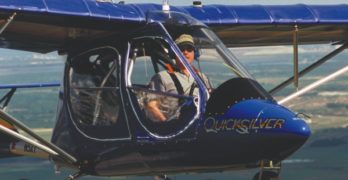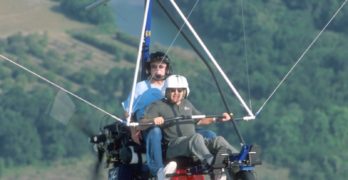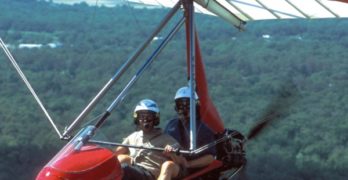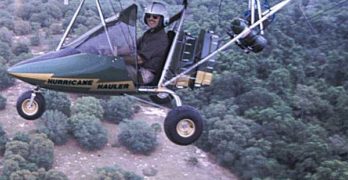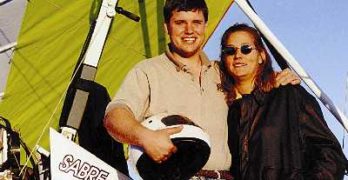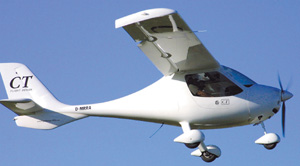St. Paul, Minn. — I don’t intend for “Product Lines” to become a place where you read government regulatory updates (God forbid!) but I was in a place to hear some recent developments that I believe you’ll find of interest …some of you anyway. That place was Kansas City, where several ASTM groups gathered for rule-writing Committee Week in mid-May 2003. • At first, I shied away from this whole ASTM rule-writing business as it sounds dull and far from flying fun (and it is, believe me). But this is an historic opportunity to affect federal rule making that directly impacts hang gliding and powered ultralights (two activities that draw my focus). ••• OK, let’s say you’re interested as well — and you should be if towing or tandem flying is part of your hang gliding or paragliding. What the heck is ASTM* anyway? • ASTM has created a group, creatively called “F37,” that will help guide industry officials to build the new standards for Light Sport Aircraft.
Search Results for : BRS parachute
Not finding exactly what you expected? Try our advanced search option.
Select a manufacturer to go straight to all our content about that manufacturer.
Select an aircraft model to go straight to all our content about that model.
Product Lines – May 04
St. Paul, Minn. — Time is growing short! Perhaps by the time you read this, FAA may have issuedtheir new rule called Sport Pilot/Light-Sport Aircraft (SP/LSA). • Why should you care? Well, perhaps you don’t. If you fly solo in your hang glider or paraglider and are not towed aloft by a tug of some kind, you may continue to operate under F.A.R. Part 103 as blissfully as ever. However, if you’re one of the many who enjoy aerotow launches, you may be impacted by this rule. • The good news is… the trio of Jayne Depanfilis, Mike Meier, and Bill Bryden have been pursuing actions on the new rule and have the matter quite well in hand. The issues of two-place flying have been addressed and face few obstacles. Aerotowing, however, is less certain. Operations such as Lookout Mountain Flight Park have been fighting local battles with adversaries who brought FAA into the picture.
Product Lines – March 03
St. Paul, Minn. — Welcome to a new era for your magazine. After two tests and two surveys of the membership, USHGA has launched its new combined magazine. s I touched on this last month as I congratulated Gil Dodgen for his 25 years of service. But the magazine you are holding is indeed the most significant physical product of USHGA. Hope you’re enjoying the new look. lll These magazine changes come amid another sweeping change in American light aircraft operation. FAA is expected to release its new Sport Pilot and Light Sport Aircraft rule in the summer or fall of 2003. Many European powered aircraft makers are paying very close attention to this development as they see a golden opportunity to enter the world’s largest aviation marketplace. True, hang gliders and paragliders are well protected from the heavy hand of the law by virtue of the USA’s simple Part 103 rule which will NOT change.
Silent Trikes
Meet the Silent family of sleek trikes
Most trikes (powered hang gliders) use fiberglass only for nose pods and wheelpants. The Silent brand of trikes from Germany is an exception as these machines use composite materials for much of the trike carriage or chassis. The Silent family includes four models, two of which are still in production.
Although the Silent trikes are well known to Germans and other Europeans, it took Australian light aviation pioneer Bill Moyes to introduce the stunning Silent Racer to American skies. I first came across this unusual machine at Florida’s Wallaby Ranch before the Sun ’n Fun airshow three years ago.
But I’ve had other contact with developer Helmut Grossklaus as he has, not once, but twice been saved by the same BRS parachute installed in his aircraft. I collected info about this in my role at BRS. Neither accident was the fault of the equipment but of flying circumstances.
First to Achieve Light-Sport Aircraft Status?
Discounting coordination qualities, steep turns, well, all turns went very well in the GT 500; it is very precise in handling. You can always point the plane where you wish.
Many pilots, especially those trained in general aviation aircraft, love the yoke. I much prefer a joystick. This is personal preference, but you can’t fault the execution of the yoke arrangement in the GT 500. Like all components, it’s very well done.
Since I’d just flown the Flight Design CT before the
GT 500, comparisons were easy. Handling in the composite CT aircraft was much more fluid (though that may not suit everyone). The CT could also fly nearly as slowly over the fields as the GT 500, showing the possibilities in new aircraft designs.
The GT 500 behaved very properly at speed. Cruising at 90 mph indicated, the design felt very solid and gave every assurance. However, at 4,200 rpm and 50 to 55 mph, I experienced almost a continuous shudder that seemed to come from the tail.
Simple, But Efficient – The TC Trike
The itch returned. In truth it never left, says TC’s Trikes owner TC Blyth.
“I was a hang glider pilot 20 years ago and when the time was right, I wanted to jump back in,” says Blyth.
But instead of returning to hang gliding, trikes are the machines Blyth chose to reinvigorate his flying. A Chattanooga, Tennessee native, Blyth’s familiarity with tailless delta wings stimulated him to get involved with trikes.
After his earlier time enjoying hang gliding, family and work responsibilities “interfered” with this enjoyment for many years. Many ultralight enthusiasts can understand this situation. In the interim Blyth took up fishing, but he says, “Stumbling around among rocks in moving water had hazards, too. You can trip and fall, and drown.” While he enjoyed fishing, he figured the risks of flying weren’t overwhelming and he itched to fly again.
Blyth started by representing Sabre Aircraft and reports selling many trikes for the Southwestern company.
South Africa’s Aerotrike Goes First Class
First came the Aerotrike. Travelling all the way from South Africa where Rainbow Aircraft manufactures it, the Aerotrike looked to be – and is – a very sturdy trike that could stand the rigors of flight instruction. However, some thought it lacked the finesse of the finest European trikes.
Designed by Mike Blyth, the Aerotrike was built precisely for the purpose of flight training. For years, Blyth had used other brands of trikes in his flight school. However, he found they wore out prematurely. This is never a good thing to a school trying to fund itself by teaching many students.
The Aerotrike’s Scout and Safari models proved to be durable flying machines. Former American representative Rob Rollison fitted his Aerotrike with a reliable HKS 4-stroke engine and proceeded to fly a lengthy 2,000-mile journey around Mexico. Not everyone would tackle such a venture, but Rollison says the HKS and his sturdy Aerotrike gave him the confidence to simply fly and enjoy.
HKS Hurricane Hauler
Last year, the 60-hp HKS 700E 4-cycle engine burst on the ultralight scene with more impact than I’ve noted since Rotax established itself as the engine of choice for ultralight enthusiasts. Among those embracing the new designed-for-light-aircraft powerplant was HY-TEK Hurricane, manufacturer of the Hurricane brand.
In the years since Mike Kern took over the Hurricane, he has shown savvy about the ultralight marketplace. He was able to see where he could enlarge his potential customer base, and his quick acceptance of the newly-available engine proves this.
Despite years of good success with high power-to-weight ratio 2-stroke engines, lots of would-be ultralight buyers remain unconvinced. A Hurricane with a 4-stroke gives HY-TEK the chance to appeal to those buyers and more.
In addition to ultralight enthusiasts looking for more, Kern sees a market in those hordes of Cessna drivers who want something different. A new Hurricane with the HKS 700E fitted is priced below all but the most worn-out general aviation planes, and can be more fun than operating a heavier aircraft that was built as a transportation device rather than a joy machine.
Aeros Venture from Sabre
Only a little more than 10 years ago, the wall fell in Berlin, Germany and Communism collapsed in the USSR. Before these momentous events, few Americans knew anything about the Ukraine (which was part of the USSR) and even those who did were largely unaware of its ability to produce aircraft.
Yet by the mid-1990s, some Americans became aware of a Ukrainian company named Aeros. One man became an importer of their hang glider line. G.W. Meadows and his Thermal Riding Vehicles business sold so many hang gliders from the former Soviet satellite that the American market leader, Wills Wing, had to drop prices to remain competitive with the lower cost hang gliders from eastern Europe.
In this article I’ll review the Venture, the newest Aeros model for the American ultralight market. But this new Aeros ultralight follows the Aeros Antares (once known as Graffiti), reviewed in the December 1997 issue of Ultralight Flying!
Fixed -Wing or Flex-Wing
This month I wrote a pilot’s report about two widely different aircraft, both of which are imported by Rollison Airplane Company. Here’s how I handled it.
Every “Ultralight Flying! Pilot’s Report” has common elements: a main article, photos and photo legends, specifications, and our exclusive “Report Card.” Because the two subject flying machines are so different this month, I’ve prepared a “Report Card” for each aircraft. I did the same for specifications as the standard and optional features obviously differ too much for grouping.
In the main article, I take alternate looks at the two flying machines as a way to observe their differences, but further how they each have their benefits.
I also selected more photos – even though Ultralight Flying! reports regularly present many photos of ultralights being reviewed as readers often say that photos are a key informative element.
Because reviewing two different craft makes for a longer pilot report, I’ve somewhat abbreviated both the main article and the twin “Report Cards.”
Quite a few general aviation pilots recognize that ultralights offer a different way to fly| and that’s precisely what they like about them.
- « Previous Page
- 1
- …
- 6
- 7
- 8
- 9
- 10
- …
- 18
- Next Page »


